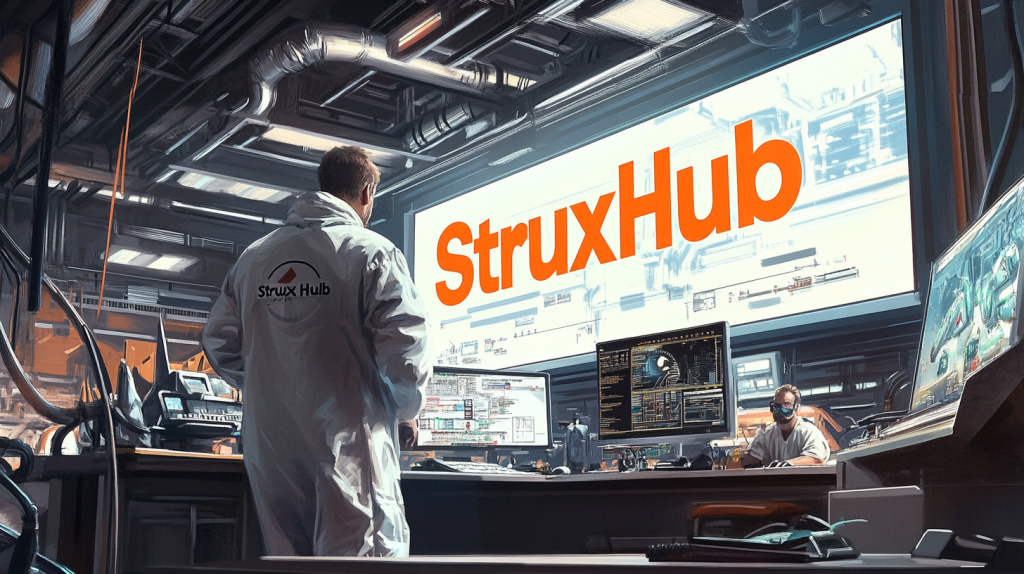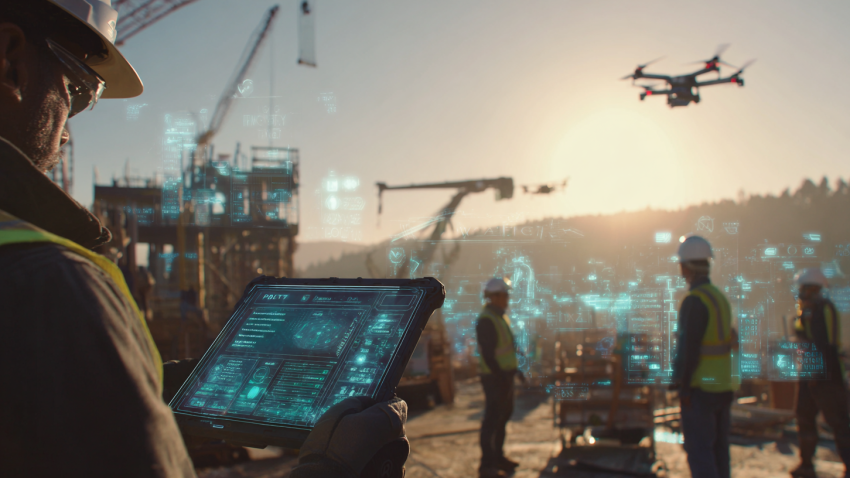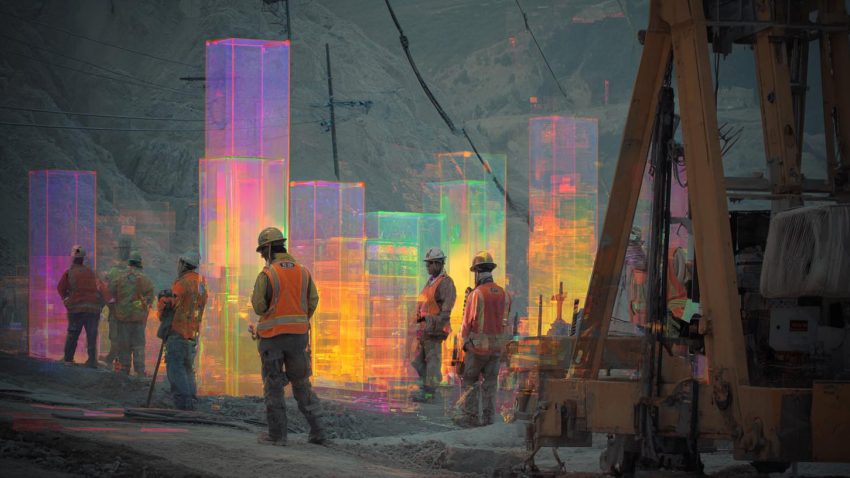The History and Evolution of Hard Hats to Smart Helmets in Construction
Table of Contents:
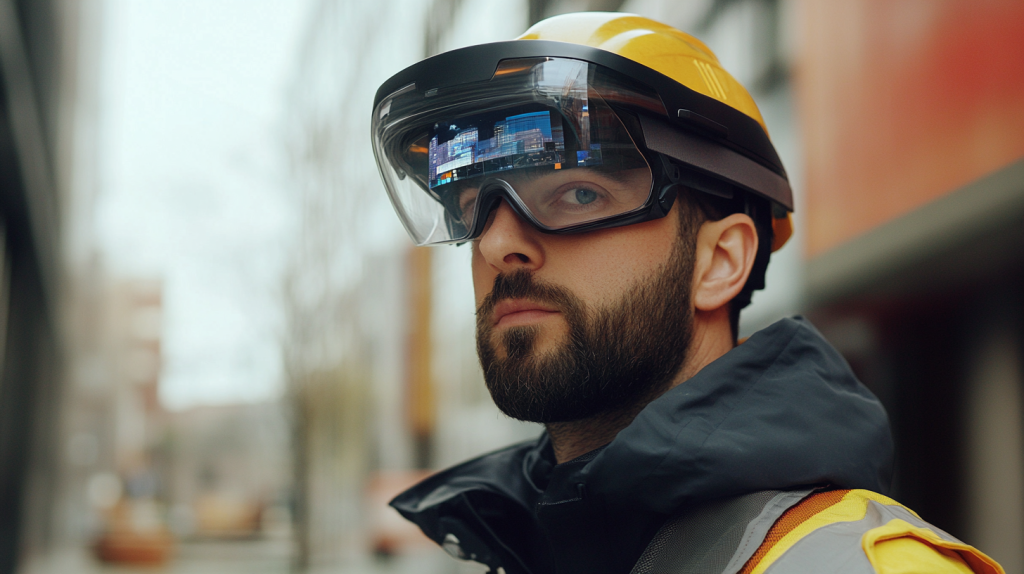
Today’s construction sites are packed with cutting-edge technology — from drones and 3D scanning to cloud-based coordination platforms. But one of the most iconic and unchanged pieces of safety equipment has quietly undergone a major transformation: the humble hard hat. What began as a simple shell for head protection has evolved into a digitally-enhanced, sensor-packed wearable that supports real-time communication, augmented reality, and live jobsite visibility.
This article traces the history of the hard hat — from its early industrial roots to the modern rise of smart helmets. Along the way, we’ll explore how construction safety has evolved, what triggered these changes, and how wearable tech is shaping the future of site supervision, safety culture, and field management.
Whether you’re a superintendent who remembers when “paper plans” ruled the trailer, or a tech-forward PM looking to outfit your team with the latest gear, this guide connects the past, present, and future of one of the most recognizable tools in the industry.
Where It All Began: The Origins of the Hard Hat
Before there were OSHA standards, PPE programs, or safety briefings, jobsite safety was mostly based on luck and common sense. The original hard hat — or what would become one — was developed in the early 1900s by E.D. Bullard, a mining equipment company owner in California. Inspired by military helmets from World War I, Bullard’s “Hard Boiled Hat” was made of steamed canvas, glue, and black paint — a simple design, but revolutionary for the time.
In those days, falling debris, head injuries, and even death were common in industrial settings, yet very little standardized protection existed. Bullard’s invention gained traction when the Golden Gate Bridge project in the 1930s became the first major U.S. jobsite to require hard hats. It marked a turning point in jobsite culture — and the beginning of personal protective equipment (PPE) as we know it.
Problems
- Early industrial sites lacked basic head protection
- No safety regulations or PPE enforcement standards
- High injury and fatality rates from falling objects and overhead hazards
Solutions
- Military-inspired helmet designs adapted for industrial use
- Introduction of standardized protective headgear across major projects
- Adoption by federal infrastructure programs helped spread usage
Best Practices
- Understand the origins to better appreciate today’s safety culture
- Use hard hat history as a training tool during new worker onboarding
- Incorporate PPE awareness into your company’s safety storytelling
The hard hat wasn’t just a helmet — it was a mindset shift that helped construction evolve from dangerous to disciplined. Its impact on culture set the stage for everything that followed.
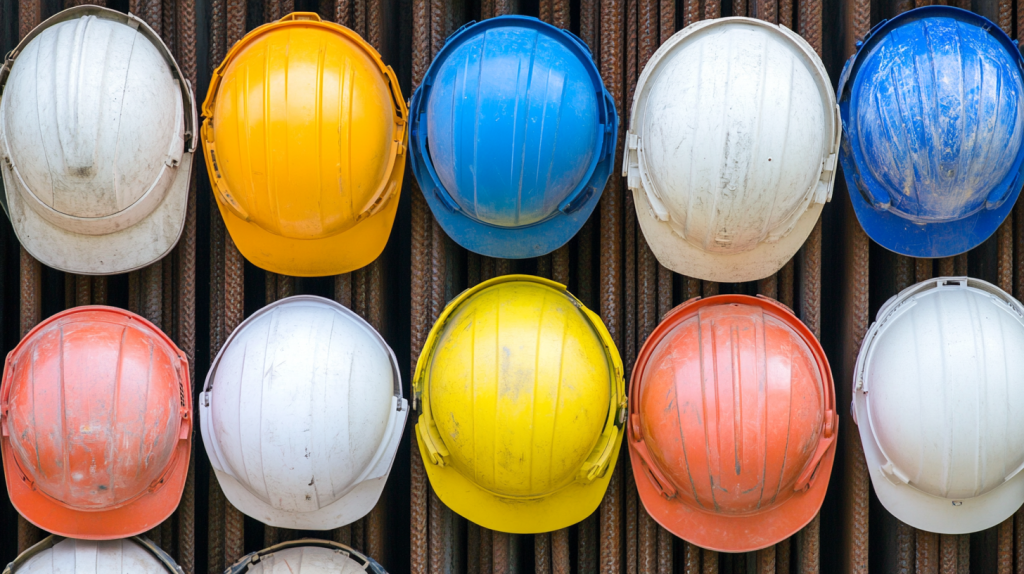
From Plastic Shells to Full-Scale Protection: How Hard Hats Improved Over Time
By the mid-20th century, hard hats had gone from niche innovation to industry standard — but that didn’t mean the evolution stopped. Early designs were made from canvas or aluminum, but eventually, thermoplastics and fiberglass became the norm, offering better protection, comfort, and durability.
The 1970s brought a wave of transformation. With OSHA’s creation in 1971 and increased focus on jobsite safety, hard hat requirements became law across the U.S. Contractors had to comply — and manufacturers began investing in research and innovation. Hard hats were now lighter, more ergonomic, and customizable with accessories like face shields, earmuffs, and visors.
Eventually, colors were standardized for roles (white for supervisors, yellow for general labor, etc.), and new features like suspension systems and vented caps made them more practical for all-day wear.
Problems
- Early helmets were bulky, heavy, and often uncomfortable
- Limited protection beyond falling objects (e.g., electrical, impact, debris)
- Crews sometimes resisted wearing gear due to discomfort or style
Solutions
- Adoption of injection-molded plastics for lighter weight and better shock absorption
- Adjustable suspension and padded liners improved fit and comfort
- Customization (logos, colors, accessories) helped boost compliance
Best Practices
- Continue evolving safety gear based on field feedback
- Choose the right style and type of helmet for specific tasks (e.g., Class G, E, C)
- Leverage personalization (logos, names, colors) to improve buy-in from teams
The better the helmet, the more likely your crew is to wear it — and wear it right. These upgrades weren’t just technical; they were cultural, helping cement safety as part of daily jobsite life.
The Smart Helmet Era: Where Safety Meets Technology
Today’s smart helmets are a far cry from the early canvas caps. These high-tech headsets now include augmented reality displays, built-in cameras, live-streaming capabilities, voice control, GPS, and environmental sensors. Instead of just shielding a worker from falling debris, smart helmets help them visualize hidden infrastructure, communicate hands-free, and capture documentation as they work.
This leap didn’t happen overnight — it’s the result of years of merging safety culture with digital innovation. Smart helmets are especially valuable on complex jobs like hospitals, data centers, or vertical construction, where real-time coordination and visibility can make or break the schedule.
Major players like Trimble (XR10), RealWear, and Guardhat are pushing the space forward. These systems are changing how construction teams approach everything from quality control to remote walkthroughs — without compromising safety.
Problems
- Traditional PPE doesn’t support modern workflows like BIM or remote inspections
- Teams often lose time switching between tools or waiting on updates
- On-site documentation and safety reports are time-consuming and error-prone
Solutions
- Smart helmets allow workers to see BIM overlays in real space
- Real-time video and voice updates reduce the need for back-and-forth coordination
- Sensor-based alerts keep workers aware of environmental risks on-site
Best Practices
- Pair smart helmets with BIM workflows for maximum field value
- Use helmet footage to support QA/QC and documentation
- Assign digital tasks or punchlist items based on field-captured insights
Smart helmets represent the next leap forward — blending protection, awareness, and productivity into one wearable tool that’s redefining how teams work on the ground.
The Role of Smart Helmets in Today’s Safety Culture
Smart helmets aren’t just flashy gadgets — they’re part of a larger shift in how construction teams think about safety, accountability, and efficiency. Today’s jobsite safety culture has evolved beyond checklists and toolbox talks. It’s about creating a proactive environment where risks are identified early, communication is continuous, and documentation happens in real time.
Smart helmets help enable this culture by giving workers and supervisors more awareness and autonomy. A safety manager can’t be everywhere at once, but with helmet sensors monitoring gas levels or heat exposure — and cameras capturing site conditions — field teams become more empowered to identify and respond to issues on the spot.
For companies aiming to reduce incident rates, comply with evolving standards, or boost field productivity, these devices can act as a digital extension of your safety protocols.
Problems
- Safety teams are stretched thin on large or multi-site projects
- Lag between observation and documentation reduces incident response time
- Paper-based safety logs and manual inspections are prone to error
Solutions
- Smart helmets provide real-time safety data and incident documentation
- Workers gain tools to self-monitor risks and conditions
- Visual and audio logs support faster compliance and auditing
Best Practices
- Use smart helmet footage in weekly safety briefings and incident reviews
- Train crews on how helmet sensors and alerts support — not replace — safety managers
- Incorporate helmet data into monthly safety KPIs or reporting dashboards
Modern safety culture isn’t just about rules — it’s about visibility, responsiveness, and trust. Smart helmets help turn safety from a checklist into a shared responsibility across the crew.
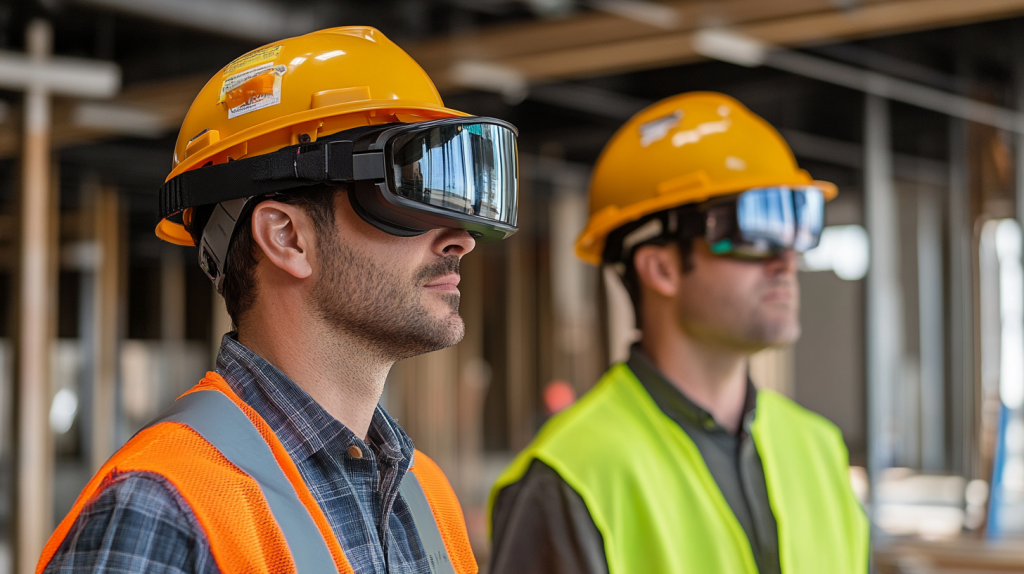
Adoption Challenges and the Real Cost of Wearable Tech
Despite the benefits, smart helmets still face resistance in the field. Cost is the most obvious hurdle — with units priced between $1,500 and $5,000, outfitting even a small team can feel like a major investment. But cost alone isn’t the only issue.
Adoption challenges often include skepticism from field crews, discomfort during extended wear, short battery life, and concerns about being “watched” or recorded. If rolled out poorly, even the best helmet can end up collecting dust in a locker instead of making a difference in the field.
Integration is another challenge. If footage, alerts, or notes captured by the helmet don’t tie back to your project systems, they lose value — and adoption drops. That’s why successful rollouts need to prioritize people, not just the tech.
Problems
- High up-front cost limits accessibility for small to mid-sized contractors
- Poor training or rollout leads to low adoption or resistance
- Data collected by helmets often lives outside core workflows
Solutions
- Start with targeted pilot programs focused on high-impact teams or projects
- Build workflows around the most valuable helmet features (e.g., QA/QC, remote reviews)
- Choose helmet systems that are easy to use and comfortable to wear
Best Practices
- Offer incentives or recognition to early adopters and pilot users
- Rotate helmet-equipped roles during critical phases like inspections or handoff
- Gather crew feedback during rollout to fine-tune training and workflows
Adoption isn’t just about what helmets can do — it’s about how well they’re introduced. The goal is alignment: between tech, people, and purpose.

StruxHub
Experience the power of StruxHub today and witness firsthand how it can revolutionize your construction operations.
What’s Next? The Future of Wearable Technology in Construction
If smart helmets are the present, the future is even more exciting. Wearable tech in construction is poised to expand rapidly — from biometric monitors to exoskeletons and smart glasses. As sensors become smaller and software becomes more connected, we’ll see more tools that help contractors monitor safety, improve workflows, and reduce jobsite risk in real time.
We’re already seeing emerging wearables that monitor heart rate, hydration, or fatigue to help prevent heat stroke or overexertion. Others use geofencing to create virtual safety zones, alerting workers when they step too close to dangerous equipment or fall hazards.
What ties all of this together is the push toward connected jobsite ecosystems — where data flows seamlessly from person to platform, and insights are shared across the organization.
Problems
- Construction still faces labor shortages, safety risks, and productivity pressure
- Teams struggle with real-time oversight across large or complex sites
- Many wearables create data that isn’t used effectively
Solutions
- Emerging tech is building smarter, more adaptive safety solutions
- New platforms allow data from multiple devices to be visualized in one place
- Construction culture is shifting toward digitization and transparency
Best Practices
- Stay updated on wearable trends and pilot opportunities in your region
- Evaluate new tech with a clear workflow or business goal in mind
- Involve field teams early when testing new devices or programs
Wearable tech won’t solve every challenge overnight, but it will redefine how construction teams work — not just in how they build, but in how they think, respond, and evolve.

How StruxHub Supports Smarter Field Coordination Without Hardware Integration
While smart helmets and other wearables enhance what’s happening in the field, they’re just one part of the puzzle. The real key to success is making sure that information is captured, tracked, and used to drive progress. That’s where StruxHub fits in — as the construction management platform that brings all your field activity into focus, even if it’s not directly tied to a device.
StruxHub doesn’t connect to hardware — and that’s by design. Instead, it helps project teams turn the outputs of smart helmet workflows (like photos, field notes, or voice updates) into structured actions: safety logs, RFIs, punch items, daily reports, or issue tracking. By organizing and aligning all this information, StruxHub gives project managers, superintendents, and field teams the visibility they need to move faster and make better decisions.
Smart helmets can capture what’s happening — StruxHub helps do something with it.
Problems Solved by StruxHub
- Scattered documentation from field tech with no central tracking
- Delayed communication between office, trailer, and crew
- Difficulty turning observations into actions across teams
Why It Works
- Project data is organized by task, team, and timeline — no more scattered updates
- Everyone works from one central source, no matter the device they use in the field
- Field insights from wearables can be logged and tracked without complex integration
Best Practices
- Create structured folders for smart helmet footage linked to reports
- Assign action items from field observations directly in StruxHub
- Use visual dashboards to summarize risks, issues, or trends from the jobsite
StruxHub isn’t trying to replace your field tech — it’s there to amplify it. By supporting smarter, more organized workflows, it ensures that every observation, every update, and every piece of data has a clear path from the field to decision-makers.
Unlock the Full Potential of Your Construction Projects with StruxHub
StruxHub enhances efficiency and coordination across all project phases, providing a single source of truth that eliminates silos and fosters collaboration. Real-time updates, financial management tools, and seamless commvunication features ensure that all team members and stakeholders are aligned and informed, reducing the risk of errors and delays. With comprehensive solutions for document management, risk mitigation, and quality control, StruxHub maintains project integrity and safety, while mobile access and integration capabilities further enhance project flexibility and efficiency.
StruxHub’s Key Features and Benefits:
- Advanced Delivery Management: Automate and optimize your delivery schedules, ensuring materials arrive just in time, every time.
- Site Communication: Utilize georeferenced maps and instant messaging to keep every team member informed and aligned.
- Construction Materials Management: Track inventory levels and manage materials procurement with ease, reducing waste and avoiding project delays.
- Construction Safety & Inspection Workflows: Implement customizable mobile forms for conducting safety inspections and managing compliance documentation effortlessly.
- Short-Term Scheduling: Visualize project tasks with detailed floor plans, linking each activity to specific locations for better planning accuracy.
- Construction Resource Management: Efficiently allocate personnel and equipment, maximizing productivity and reducing idle time.
StruxHub’s Product Offering:
- StruxHub Deliveries: Simplifies the coordination of incoming deliveries, ensuring materials and equipment are precisely timed to project needs.
- StruxHub Logistics: Offers intelligent site logistics planning, from crane scheduling to space allocation, for smoother operations.
- StruxHub Safety: Elevates on-site safety standards with easy-to-use tools for inspections, permits, and incident reporting.
- StruxHub Scheduling: Enhances project timelines with intuitive scheduling tools that ensure tasks are completed efficiently and on time.
With StruxHub, construction companies can look forward to a streamlined, more efficient project execution that delivers on time and within budget. Embrace the power of innovation and take your construction projects to the next level.
Don’t miss out on the opportunity to optimize your construction management processes with StruxHub. Sign up for a free demo today. Let’s build smarter, together.
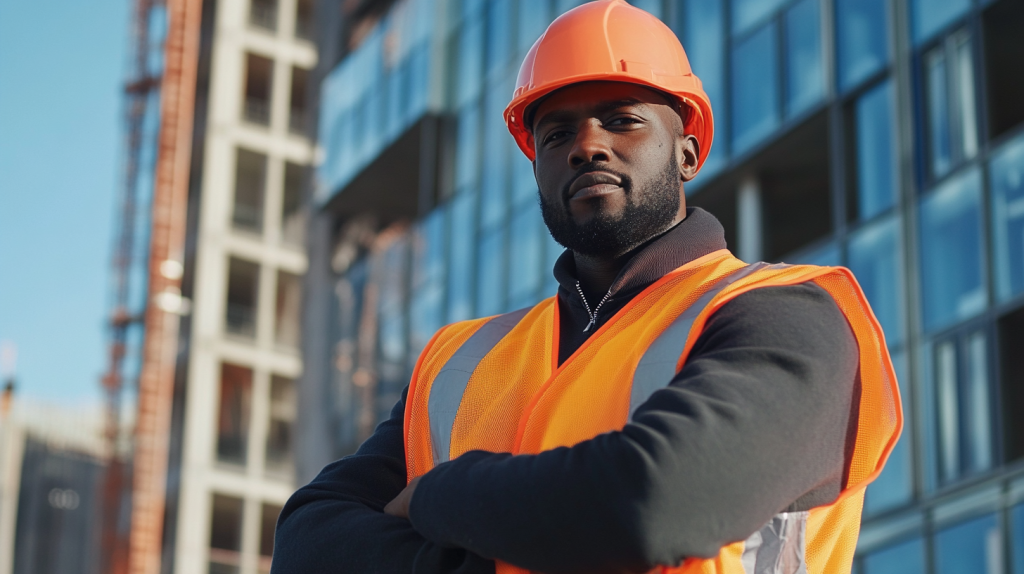
FAQ
Are smart helmets actually improving safety on construction sites?
Yes — smart helmets are proving to be a powerful tool in improving safety across construction sites, especially those with complex risks and fast-changing conditions. These helmets go far beyond standard PPE by incorporating real-time monitoring, hazard alerts, and live communication tools that give field workers more visibility and faster reaction time.
For example, a smart helmet with built-in gas sensors can alert a worker to dangerous air quality before entering a confined space. Others include GPS and location-based alerts, which can warn users when they approach dangerous zones, like crane swing areas or excavation pits. Some models also include fall detection or heat stress monitoring, helping supervisors identify problems before they become emergencies.
The result? Faster incident response, fewer near misses, and stronger overall safety culture. Teams using smart helmets are also capturing more accurate field data — like video documentation and voice memos — which help with post-incident reviews, safety training, and accountability.
While the tech is still evolving, there’s no doubt that smart helmets are actively reducing risk and enabling more proactive site safety strategies, especially when paired with supportive construction management software like StruxHub.
How do smart helmets work in noisy construction environments?
Smart helmets are designed specifically for loud, chaotic jobsite conditions. Many models use bone-conduction audio, noise-canceling microphones, and push-to-talk communication systems that function even in environments with jackhammers, lifts, or heavy equipment operating nearby.
This makes them especially useful for foremen, crane spotters, and safety leads who need to communicate clearly but can’t rely on hand signals or two-way radios. Because the communication is integrated into the helmet, workers can respond hands-free while keeping their focus on the task at hand — whether they’re tying rebar or managing an active lift.
In addition to verbal communication, many smart helmets can provide visual alerts or haptic (vibration) cues, so workers receive safety messages even when they can’t hear them. This multi-sensory approach helps reduce communication breakdowns and ensures critical messages don’t get lost in the noise.
By streamlining communication in noisy environments, smart helmets help field teams stay coordinated, respond faster, and avoid accidents caused by miscommunication.
Are smart helmets a good fit for small or mid-sized construction companies?
Yes — and in fact, many small to mid-sized firms are adopting smart helmets strategically, starting with select roles or projects where the return on investment is clearest. You don’t need to outfit your entire workforce to see the benefits.
For example, equipping just your superintendents, safety officers, or QA/QC leads with smart helmets can enhance site oversight, improve reporting accuracy, and streamline communication with project stakeholders. These helmets can also replace or reduce the need for separate radios, body cameras, or manual inspection reports — consolidating several tools into one.
Additionally, mid-sized contractors are using smart helmet footage to document jobsite conditions, reduce liability, and protect against claims. If a hazard is spotted or a delay occurs, you have visual records with timestamps — which can be invaluable during project closeout or legal disputes.
Even without full integration into your tech stack, smart helmets serve as a stepping stone toward modernizing your field operations. And when combined with platforms like StruxHub, you can turn helmet-collected data into structured tasks, logs, and updates without needing a full IT team to manage the process.
What safety data can smart helmets capture — and how should teams use it?
Smart helmets can capture a wide range of field-level safety data, including:
- Environmental conditions (e.g., gas levels, temperature, noise)
- Live video and photo documentation of site conditions
- Voice memos describing hazards or instructions
- Location tracking for movement monitoring or geofencing alerts
- Worker activity (e.g., falls, fatigue, long exposure in hazardous zones)
The challenge isn’t just capturing this data — it’s using it effectively. That’s where construction software like StruxHub comes in. Teams can upload helmet footage, transcribe voice notes, and log safety incidents into their daily reporting or safety workflows. This creates an audit trail that helps resolve issues faster, informs toolbox talks, and supports compliance reporting.
Using this data wisely allows companies to spot safety trends, improve crew training, and reduce recurring issues. It also gives safety managers a clearer picture of what’s happening across the site — especially on large or multi-phase builds where manual inspection isn’t always possible.
Do smart helmets integrate with construction management platforms like StruxHub?
Smart helmets don’t need to integrate directly with construction platforms to be useful. While some manufacturers offer API connectivity, most field teams use smart helmet data as standalone outputs — such as videos, photos, or alerts — which are then manually uploaded or linked to their project management system.
This is where platforms like StruxHub shine. Even without hardware integration, StruxHub helps teams organize smart helmet data in a meaningful way — by connecting it to RFIs, punchlists, safety logs, or daily reports. Field observations become actionable. Issues are assigned and tracked. And safety updates get shared across office and site without the confusion of siloed emails or folders.
So while StruxHub doesn’t directly connect to smart helmets, it plays a crucial role in turning raw field data into structured project action. That’s what keeps teams moving — and safer.

